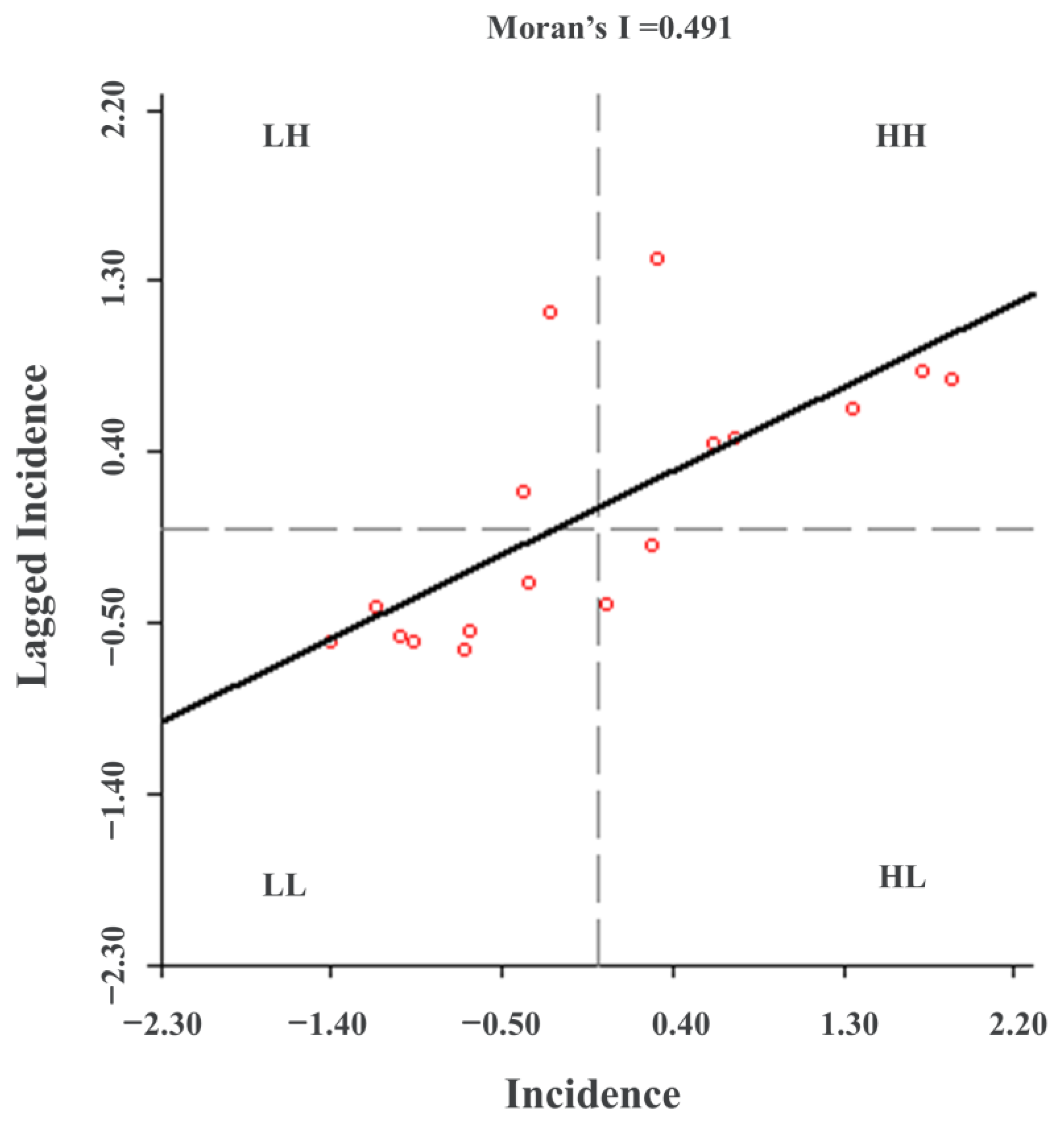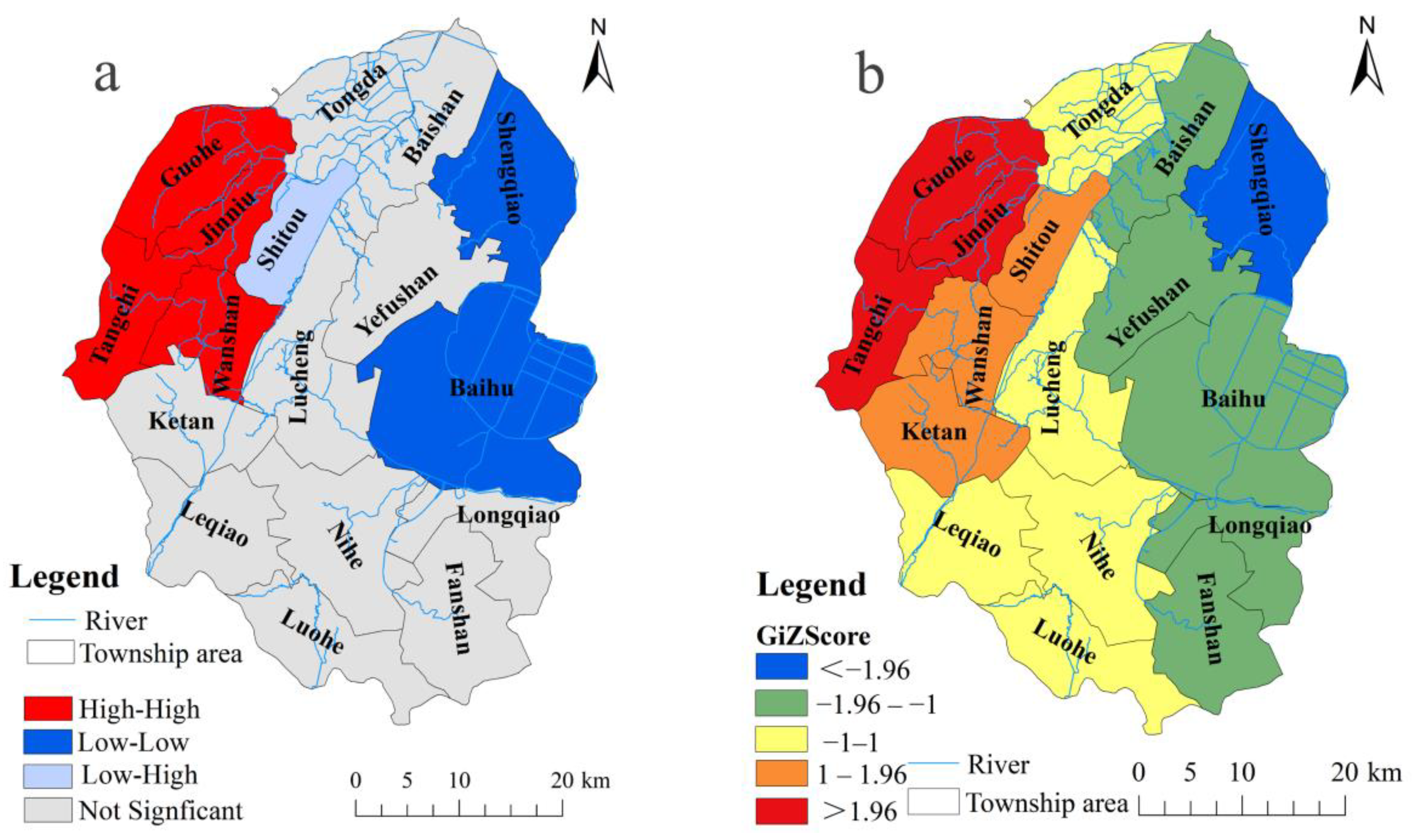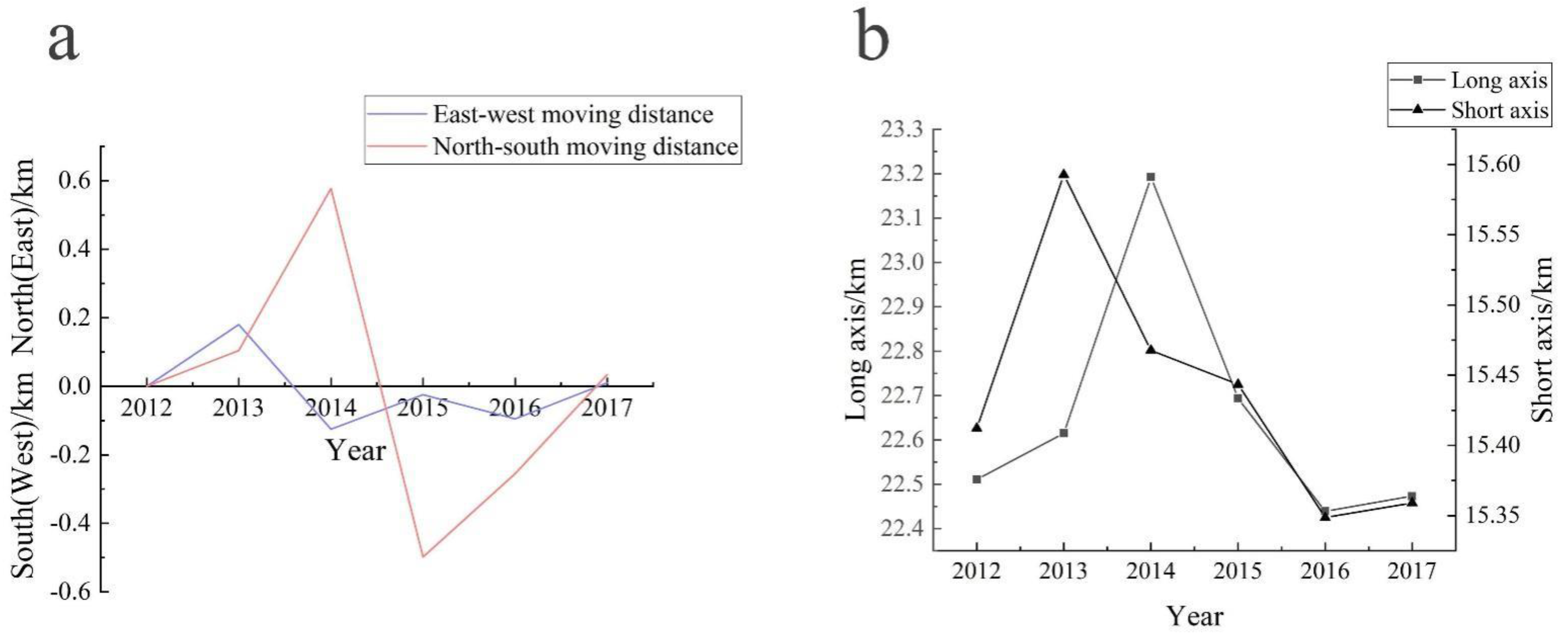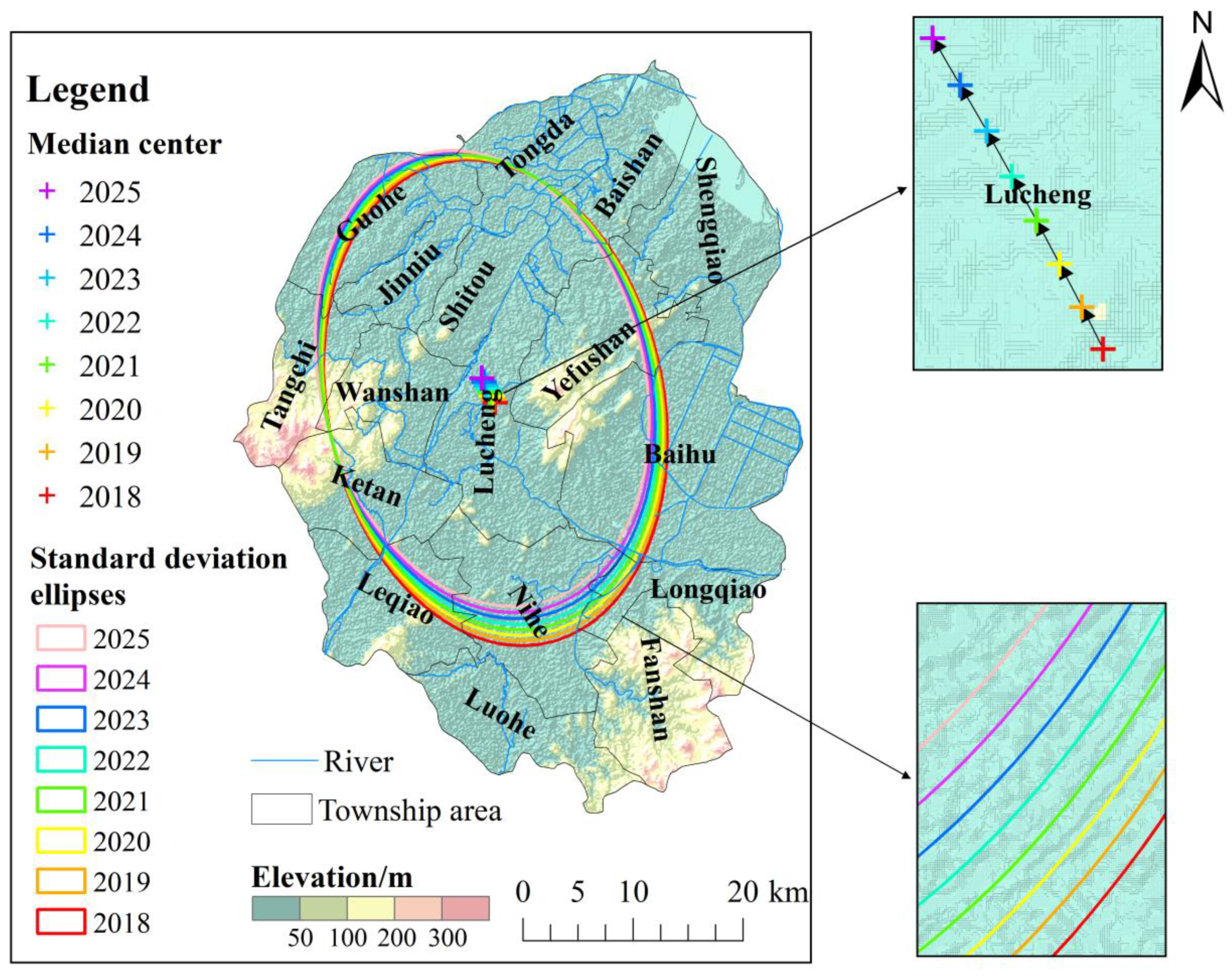Spatiotemporal Distribution and Evolution of Digestive Tract Cancer Cases in Lujiang County, China since 2012
Abstract
:1. Introduction
2. Materials and Methods
2.1. Study Area
2.2. Data Sources and Processing
2.3. Statistical Methods
2.3.1. Spatial Empirical Bayes Smoothing (SEBS) Analysis
2.3.2. Spatial Autocorrelation Analysis
2.3.3. Hot Spot Analysis
2.3.4. Retrospective Spatiotemporal Scan Statistical Analysis
2.3.5. Standard Deviational Ellipse (SDE) Analysis
2.3.6. Grey System Theory Model (1,1) Analysis
3. Results and Discussion
3.1. Spatiotemporal Distribution of Digestive Tract Cancer
3.2. Spatiotemporal Clustering of Digestive Tract Cancer
3.3. Spatiotemporal Evolution of Digestive Tract Cancer
4. Conclusions
Supplementary Materials
Author Contributions
Funding
Institutional Review Board Statement
Informed Consent Statement
Data Availability Statement
Conflicts of Interest
Abbreviations
References
- GBD 2019 Diseases and Injuries Collaborators. Global burden of 369 diseases and injuries in 204 countries and territories, 1990–2019: A systematic analysis for the Global Burden of Disease Study 2019. Lancet 2020, 396, 1204–1222. [Google Scholar] [CrossRef]
- GBD 2019 Diseases and Injuries Collaborators. Global burden of 87 risk factors in 204 countries and territories, 1990–2019: A systematic analysis for the Global Burden of Disease Study 2019. Lancet 2020, 396, 1223–1249. [Google Scholar] [CrossRef]
- World Health Organization. World Cancer Report 2020: Cancer Research for Cancer Prevention; WHO: Geneve, Switzerland, 2020. [Google Scholar]
- National Bureau of Statistics. National Annual Statistical Bulletin. Available online: http://www.stats.gov.cn/tjsj/tjgb/ndtjgb/index.html (accessed on 28 February 2020).
- Fei, X.F.; Lou, Z.H.; Christakos, G.; Liu, Q.M.; Ren, Y.J.; Wu, J.P. Contribution of industrial density and socioeconomic status to the spatial distribution of thyroid cancer risk in Hangzhou, China. Sci. Total Environ. 2018, 613, 679–686. [Google Scholar] [CrossRef] [PubMed]
- Rybak, J.; Wróbel, M.; Bihałowicz, J.S.; Rogula-Kozlowska, W. Selected Metals in Urban Road Dust: Upper and Lower Silesia Case Study. Atmosphere 2020, 11, 290. [Google Scholar] [CrossRef] [Green Version]
- Torres-Roman, J.S.; Ronceros-Cardenas, L.; Valcarcel, B.; Arce-Huamani, M.A.; Bazalar-Palacios, J.; Ybaseta-Medina, J.; La-Vecchia, C.; Alvarez, C.S.l. Cervical cancer mortality in Peru: Regional trend analysis from 2008–2017. BMC Public Health 2021, 21, 219. [Google Scholar] [CrossRef]
- Danjou, A.M.N.; Patel, M.; Espina, C.; Pentz, A.; Joffe, M.; Winde, F.; Schuz, J. Prospective case-series analysis of haematological malignancies in goldmining areas in South Africa. S. Afr. Med. J. 2018, 66, 277–287. [Google Scholar] [CrossRef] [PubMed] [Green Version]
- Cui, X.F.; Cheng, H.G.; Sun, H.X.; Huang, J.H.; Huang, D.; Zhang, Q. Human health and environment: Spatiotemporal variation of Chinese cancer villages and its contributing factors. Ecol. Eng. 2020, 158, 106075. [Google Scholar] [CrossRef]
- Chen, W.; Zheng, R.; Baade, P.D.; Zhang, S.; Zeng, H.; Bray, F.; Jemal, A.; Yu, X.Q.; He, J. Cancer statistics in China. CA Cancer J. Clin. 2016, 66, 115–132. [Google Scholar] [CrossRef] [Green Version]
- Begg, S.; Rao, C.; Lopez, A.D. Design options for sample-based mortality surveillance. Int. J. Epidemiol. 2005, 34, 1080–1087. [Google Scholar] [CrossRef] [Green Version]
- Li, Y.Y.; Meng, Y.J.; Xia, L.F.; Chen, Q.Q.; Qi, X.P.; Ma, J.Q. Application of spatial empirical Bayesian smoothing to the spatial analysis of lung cancer deaths. China Digit. Med. 2014, 9, 104–106. (In Chinese) [Google Scholar] [CrossRef]
- Lai, K.; Lei, Y.; Du, Y.; Wu, G.F.; Xie, W.; Shen, H.C.; Zhong, Z.Q.; Li, T.G. Spatial and temporal characteristics of tuberculosis incidence among students in Guangzhou from 2014–2018. Chin. J. Prod. Consump. 2020, 42, 590–596. (In Chinese) [Google Scholar] [CrossRef]
- Chen, H.Y.; Ji, S.; Chu, H.T.; Chen, R.; Duan, X.W.; Hong, G.L.; Huang, F. Analysis of cancer prevalence in Lujiang county of Anhui Province during 2010–2012. Chron. Dis. 2015, 23, 113–115. (In Chinese) [Google Scholar]
- Bray, F.; Parkin, D.M. Evaluation of data quality in the cancer registry: Principles and methods. Part Ⅰ: Comparability, validity and timeliness. Eur. J. Cancer 2009, 45, 747–755. [Google Scholar] [CrossRef] [PubMed]
- Wubuli, A.; Xue, F.; Jiang, D.; Yao, X.; Upur, H.; Wushouer, Q. Socio-demographic predictors and distribution of pulmonary tuberculosis (TB) in Xinjiang. China: A spatial analysis. PLoS ONE 2015, 10, e0144010. [Google Scholar] [CrossRef]
- Rao, H.X.; Zhang, X.; Zhao, L.; Yu, J.; Ren, W.; Zhang, X.L.; Ma, Y.C.; Shi, Y.; Ma, B.Z.; Wang, X.; et al. Spatial transmission and meteorological determinants of tuberculosis incidence in Qinghai Province, China: A spatial clustering panel analysis. Infect. Dis. Poverty 2016, 5, 45. [Google Scholar] [CrossRef] [Green Version]
- Rao, H.; Shi, X.; Zhang, X. Using the Kulldorff’s scan statistical analysis to detect spatiotemporal clusters of tuberculosis in Qinghai Province, China, 2009–2016. BMC Infect Dis. 2017, 17, 578. [Google Scholar] [CrossRef] [Green Version]
- Tang, J.H.; Tseng, T.J.; Chan, T.C. Detecting spatio-temporal hotspots of scarlet fever in Taiwan with spatio-temporal Gi* statistic. PLoS ONE 2019, 14, e0215434. [Google Scholar] [CrossRef]
- Huang, L.; Li, X.X.; Abe, E.M.; Xu, L.; Ruan, Y.; Cao, C.L.; Li, S.Z. Spatial-temporal analysis of pulmonary tuberculosis in the northeast of the Yunnan province, People’s Republic of China. Infect. Dis. Poverty 2017, 6, 53. [Google Scholar] [CrossRef] [Green Version]
- Peng, J.; Chen, S.; Lü, H.; Liu, Y.; Wu, J. Spatiotemporal patterns of remotely sensed PM2.5 concentration in China from 1999 to 2011. Remote Sens. Environ. 2016, 174, 109–121. [Google Scholar] [CrossRef]
- Shi, Y.; Matsunaga, T.; Yamaguchi, Y.; Li, Z.; Gu, X.; Chen, X. Long-term trends and spatial patterns of satellite-retrieved PM2.5 concentrations in South and Southeast Asia from 1999 to 2014. Sci. Total Environ. 2018, 615, 177–186. [Google Scholar] [CrossRef]
- Wang, Z.F.; Chen, Q.Q. Spatio-temporal pattern evolution and trend prediction of tourism ecological security in the Yangtze River Economic Belt since 1998. J. Ecol. 2021, 41, 320–332. (In Chinese) [Google Scholar] [CrossRef]
- Wu, H.H.; Wang, C.; Wang, G.J.; Zhao, Q.H.; Li, L.; Chen, W.J.; Bo, Q.L.; Hu, C.L.; Hu, A.L. Relationship between the intake of salt and salted food and the infection of Helicobacter pylori in 40–69 years old local residents in a county with high gastric cancer risk in Anhui Province. Chin. J. Dis. Control 2020, 24, 164–169. (In Chinese) [Google Scholar] [CrossRef]
- Loh, J.T.; Beckett, A.C.; Scholz, M.B. High-salt conditions alter transcription of Helicobacter pylori genes encoding outer membrane proteins. Infect. Immun. 2018, 6, e00626-17. [Google Scholar] [CrossRef] [Green Version]
- Yang, K.Y.; Tu, J.T.; Li, H.M.; Shi, L.; Zhang, A.M.; He, Z.Y. Changes in the incidence of gastric cancer in Jiyuan County in two decades before and after—A re-evaluation of the relationship between geology, drinking water and gastric cancer. Tumor 1995, 1, 32–36. (In Chinese) [Google Scholar]
- Balint, L.; Tiszai, A.; Kozak, G.; Doczi, I.; Szekeres, V.; Inczefi, O.; Olle, G.; Helle, K.; Roka, R.; Rosztoczy, A. Epidemiologic characteristics of Helicobacter pylori infection in southeast Hungary. World J. Gastroenterol. 2019, 25, 6365–6372. [Google Scholar] [CrossRef] [PubMed]
- Ruan, C.C.; Chen, Y.H.; Zhang, Q. Drinking water and liver cancer. Chin. J. Gastroenterol. 1997, 3, 47–49. [Google Scholar] [CrossRef] [PubMed]
- Ishtiaq, M.; Jehan, N.; Khan, S.A.; Muhammad, S.; Saddique, U.; Iftikhar, B.; Zahidullah. Potential harmful elements in coal dust and human health risk assessment near the mining areas in Cherat, Pakistan. Environ. Sci. Pollut. Res. 2018, 25, 14666–14673. [Google Scholar] [CrossRef]
- Czaderny, K. Increasing deaths from colorectal cancer in Poland—Insights for optimising colorectal cancer screening in society and space. Ann. Agric. Environ. Med. 2019, 26, 125–132. [Google Scholar] [CrossRef]
- Perez-Panades, J.; Botella-Rocamora, P.; Martinez-Beneito, M.A. Beyond standardized mortality ratios; some uses of smoothed age-specific mortality rates on small areas studies. Int. J. Health Geogr. 2020, 19, 54. [Google Scholar] [CrossRef]
- Ali, H.; Zahir, A.; Khan, S.; Ahmad, N.; Fayyaz, A. A Hazard-Free Framework for Aerial Distribution of Pesticides on Agricultural Land. Mehran University Research. J. Eng. Technol. Manag. 2020, 39, 548–553. [Google Scholar] [CrossRef]
- Taghizadeh, S.F.; Rezaee, R.; Azizi, M.; Hayes, A.W.; Giesy, J.P.; Karimi, G. Pesticides, metals, and polycyclic aromatic hydrocarbons in date fruits: A probabilistic assessment of risk to health of Iranian consumers. J. Food Compos. Anal. 2021, 98, 103815. [Google Scholar] [CrossRef]
- Ngweme, G.N.; Al Salah, D.M.M.; Laffite, A.; Sivalingam, P.; Grandjean, D.; Konde, J.N.; Mulaji, C.K.; Breider, F.; Pote, J. Occurrence of organic micropollutants and human health risk assessment based on consumption of Amaranthus viridis, Kinshasa in the Democratic Republic of the Congo. Sci. Total Environ. 2021, 754, 142175. [Google Scholar] [CrossRef] [PubMed]








| Year | Male | Female | Both | |||||||||||
|---|---|---|---|---|---|---|---|---|---|---|---|---|---|---|
| No. Cases | Crude Rate (1/105) | ASR China (1/105) | ASR World (1/105) | No. Cases | Crude Rate (1/105) | ASR China (1/105) | ASR World (1/105) | X2 Value a | p Value a | No. Cases | Crude Rate (1/105) | ASR China (1/105) | ASR World (1/105) | |
| 2012 | 1700 | 275.30 | 202.97 | 136.10 | 679 | 118.47 | 91.25 | 58.36 | 370.19 | <0.001 | 2379 | 199.81 | 150.08 | 119.83 |
| 2013 | 1890 | 305.69 | 225.24 | 151.31 | 732 | 127.35 | 97.39 | 62.91 | 434.35 | <0.001 | 2622 | 219.77 | 164.64 | 130.71 |
| 2014 | 1796 | 289.93 | 212.24 | 143.79 | 664 | 115.39 | 88.01 | 57.07 | 445.44 | <0.001 | 2460 | 205.87 | 153.70 | 122.16 |
| 2015 | 1717 | 276.74 | 202.29 | 137.46 | 642 | 111.17 | 86.03 | 55.18 | 418.20 | <0.001 | 2359 | 196.92 | 147.46 | 116.18 |
| 2016 | 1711 | 274.41 | 200.86 | 136.98 | 687 | 118.28 | 91.08 | 59.05 | 369.09 | <0.001 | 2398 | 199.11 | 149.10 | 117.62 |
| 2017 | 1791 | 286.89 | 209.14 | 143.39 | 594 | 102.14 | 79.64 | 51.05 | 520.82 | <0.001 | 2385 | 197.79 | 148.36 | 116.59 |
| TOTAL | 10605 | 284.81 | 208.79 | 155.92 | 3998 | 115.44 | 88.90 | 60.30 | 14,603 | 203.19 | 152.22 | 109.34 | ||
| APC (%) | −0.50 | −0.70 | −0.20 | −2.86 | −2.57 | −2.57 | −1.00 | −1.10 | −1.39 | |||||
| t Value | −0.43 | −0.63 | −0.22 | −2.10 | −2.05 | −1.85 | −1.16 | −1.20 | −1.53 | |||||
| p Value | 0.69 | 0.56 | 0.84 | 0.10 | 0.11 | 0.14 | 0.31 | 0.30 | 0.20 | |||||
Publisher’s Note: MDPI stays neutral with regard to jurisdictional claims in published maps and institutional affiliations. |
© 2022 by the authors. Licensee MDPI, Basel, Switzerland. This article is an open access article distributed under the terms and conditions of the Creative Commons Attribution (CC BY) license (https://creativecommons.org/licenses/by/4.0/).
Share and Cite
Ma, K.; Lin, Y.; Zhang, X.; Fang, F.; Zhang, Y.; Li, J.; Yao, Y.; Ge, L.; Tan, H.; Wang, F. Spatiotemporal Distribution and Evolution of Digestive Tract Cancer Cases in Lujiang County, China since 2012. Int. J. Environ. Res. Public Health 2022, 19, 7451. https://doi.org/10.3390/ijerph19127451
Ma K, Lin Y, Zhang X, Fang F, Zhang Y, Li J, Yao Y, Ge L, Tan H, Wang F. Spatiotemporal Distribution and Evolution of Digestive Tract Cancer Cases in Lujiang County, China since 2012. International Journal of Environmental Research and Public Health. 2022; 19(12):7451. https://doi.org/10.3390/ijerph19127451
Chicago/Turabian StyleMa, Kang, Yuesheng Lin, Xiaopeng Zhang, Fengman Fang, Yong Zhang, Jiajia Li, Youru Yao, Lei Ge, Huarong Tan, and Fei Wang. 2022. "Spatiotemporal Distribution and Evolution of Digestive Tract Cancer Cases in Lujiang County, China since 2012" International Journal of Environmental Research and Public Health 19, no. 12: 7451. https://doi.org/10.3390/ijerph19127451
APA StyleMa, K., Lin, Y., Zhang, X., Fang, F., Zhang, Y., Li, J., Yao, Y., Ge, L., Tan, H., & Wang, F. (2022). Spatiotemporal Distribution and Evolution of Digestive Tract Cancer Cases in Lujiang County, China since 2012. International Journal of Environmental Research and Public Health, 19(12), 7451. https://doi.org/10.3390/ijerph19127451





